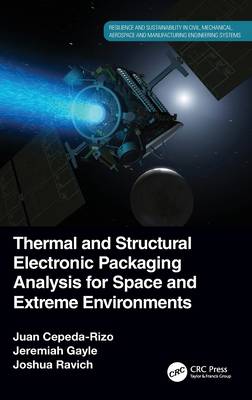
- Afhalen na 1 uur in een winkel met voorraad
- Gratis thuislevering in België
- Ruim aanbod met 7 miljoen producten
- Afhalen na 1 uur in een winkel met voorraad
- Gratis thuislevering in België
- Ruim aanbod met 7 miljoen producten
Thermal and Structural Electronic Packaging Analysis for Space and Extreme Environments
Juan Cepeda-Rizo, Jeremiah Gayle, Joshua RavichOmschrijving
Have you ever wondered how NASA designs, builds, and tests spacecrafts and hardware for space? How is it that wildly successful programs such as the Mars Exploration Rovers could produce a rover that lasted over ten times the expected prime mission duration? Or build a spacecraft designed to visit two orbiting destinations and last over 10 years when the fuel ran out? This book was written by NASA/JPL engineers with experience across multiple projects, including the Mars rovers, Mars helicopter, and Dawn ion propulsion spacecraft in addition to many more missions and technology demonstration programs. It provides useful and practical approaches to solving the most complex thermal-structural problems ever attempted for design spacecraft to survive the severe cold of deep space, as well as the unforgiving temperature swings on the surface of Mars. This is done without losing sight of the fundamental and classical theories of thermodynamics and structural mechanics that paved the way to more pragmatic and applied methods such finite element analysis and Monte Carlo ray tracing, for example.
Features:
- Includes case studies from NASA's Jet Propulsion Laboratory, which prides itself in robotic exploration of the solar system, as well as flyting the first cubeSAT to Mars.
- Enables spacecraft designer engineers to create a design that is structurally and thermally sound, and reliable, in the quickest time afforded.
- Examines innovative low-cost thermal and power systems.
- Explains how to design to survive rocket launch, the surfaces of Mars and Venus.
Suitable for practicing professionals as well as upper-level students in the areas of aerospace, mechanical, thermal, electrical, and systems engineering, Thermal and Structural Electronic Packaging Analysis for Space and Extreme Environments provides cutting-edge information on how to design, and analyze, and test in the fast-paced and low-cost small satellite environment and learn techniques to reduce the design and test cycles without compromising reliability. It serves both as a reference and a training manual for designing satellites to withstand the structural and thermal challenges of extreme environments in outer space.
Specificaties
Betrokkenen
- Auteur(s):
- Uitgeverij:
Inhoud
- Aantal bladzijden:
- 290
- Taal:
- Engels
- Reeks:
Eigenschappen
- Productcode (EAN):
- 9781032160818
- Verschijningsdatum:
- 30/12/2021
- Uitvoering:
- Hardcover
- Formaat:
- Genaaid
- Afmetingen:
- 156 mm x 234 mm
- Gewicht:
- 603 g

Alleen bij Standaard Boekhandel
Beoordelingen
We publiceren alleen reviews die voldoen aan de voorwaarden voor reviews. Bekijk onze voorwaarden voor reviews.












